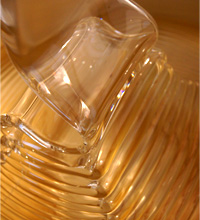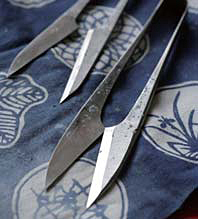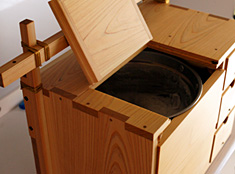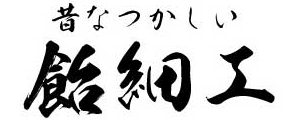Materials
Candy
The main ingredient, candy, is prepared to the proper hardness. If it is too soft, it is difficult to work with and the shape will not last long. Also, if it is too hard, it will harden too quickly and crack when scissors are used. Therefore, It takes a lot of care in preparing, taking into consideration the weather and temperature of the day.

When I went to Abu Dhabi, a country in the Middle East, for the first time, I knew about the high temperature there to some extent, but I had no information about the room temperature at the venue where I was going to demonstrate, so I brought four kinds of candies and mixed them on site to adjust them. The weight of the candies alone was over 10 kg, but even with such hard work, it was important for me to match the temperatures.
If you want to make a transparent candy, leave it transparent at the preparation stage. In the case of the traditional white candy, the candy is exposed to air and kneaded to make it what is called sarashi ame -air exposed candy (this is a bit hard process).
Food Coloring
The three primary colors (red, blue, and yellow) are used to create various colors.There are only three colors here: red, blue, and yellow. Now, how do you make green candy? It is fun to quiz the children. Then orange, then purple, and so on, and sometimes too much is done, saying, "This color is too much for candy". Also, I cannot do pitch black, although it is sometimes requested. Gray is also not recommended.
Sticks
Chopsticks or straw-like plastic sticks. In the past, yoshi reeds were used.
Tools
Scissors
Traditional-style Japanese iron scissors. Sometimes I am asked, "Are those scissors specially made for Amezaiku?" But there is no such thing. They are ordinary grip scissors. However, depending on the shape and material, some scissors are easy to use while others are not. In the world of Japanese confectionery, there is a pair of Japanese scissors with a very long handle and blade used for the "Kiku-kiri" technique -chrysanthemum cutting, but it is not suitable for Amezaiku.

One day, I thought, "These scissors work very well somehow." I looked up the scissors I was using and found that they were made by Mr. Mitsugu Tajika, who is known as one of the three masters in the world of Japanese scissors making. Looking closely, I noticed that the shape of the scissors was different from other scissors in some details, the feel of the cut, and even the sound it makes when it snaps is completely different. Unfortunately, they are no longer available.
Brushes
Fine-point brushes. Three to match the colors. Another one for the trick of attaching candy to candy.
Wooden box
Made by a woodwork specialist. Everything from materials and tools to anything else is in here.

One day, in a town where I went for a demonstration, I happened to see some woodwork that was being sold and thought, "If he is making these, he must be very good at it," so I drew up drawings and consulted with him on various matters and had it made. The wood used for the material was a single piece of the finest cypress that was used to make a shrine, and it was just left over enough the size to make it.
Pump
Rarely use this now. In the past, it was common to blow with mouth to inflate, but now a pump instead.
